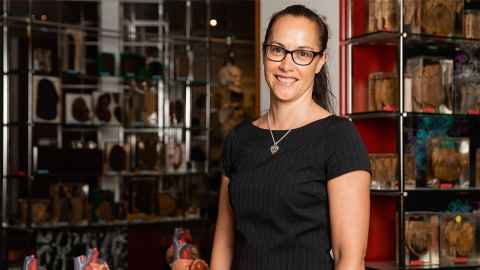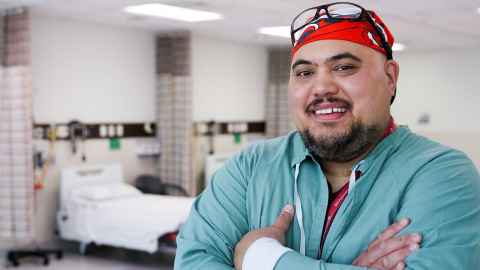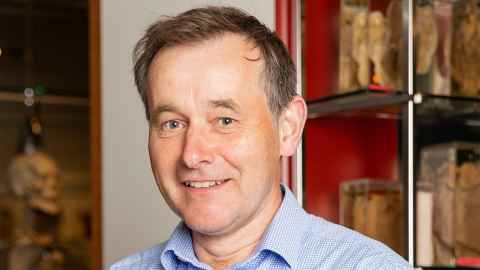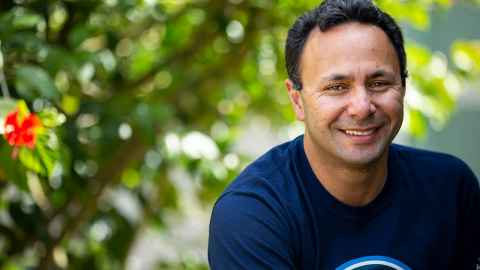Our hearts are in our hands
21 May 2021
Collaboration between communities and clinicians is vital for the cardiovascular research being undertaken at Manaaki Mānawa Centre for Heart Research.
Cardiovascular disease kills more than 30 percent of New Zealanders each year, including around 500 who are under 55. Māori death rates are twice those of non-Māori and heart disease is the leading cause of death in Pacific Peoples, at almost one in three. The University of Auckland’s Manaaki Mānawa Centre for Heart Research is collaborating with clinicians, researchers and community experts to tackle these statistics. Donna Chisholm meets people involved.

Dr Anna Rolleston sees everything that is wrong with Western approaches to heart healthcare in the faces of the clients who walk through her doors every day at the Centre for Health in Tauranga.
“These people have come to the end of their journey in the health system. They say, ‘I’ve got nothing to go to the doctor about. I’ve had a stent or bypass surgery and I’m on the right medication, but I’m not well.’ The health system doesn’t do wellness – it only helps you if there is something wrong.”
According to that system, says Anna (Ngāti Ranginui, Ngāi Te Rangi and Ngāti Pūkenga), they’re “fixed” but, in all senses of the words, they’re sick at heart.
“We know that putting a stent in your heart doesn’t make people well. It fixes a small aspect of something that causes an illness.”
Now, as co-director of Healthy Hearts for Aotearoa New Zealand (HHANZ), a new Centre of Research Excellence (CoRE) for heart health equity hosted by the University of Auckland, she and a multidisciplinary team of scientists have the chance to change that.
HHANZ will receive $40.5 million in government funding over the next seven and a half years. One of its key goals is to address the shameful seven- to eight-year gap in life expectancy between Māori and Pacific Peoples and the rest of the population and help to shape a healthcare system that better meets their needs. In turn, that will help improve New Zealand’s overall heart healthcare statistics across the whole population.
HHANZ draws together a national network of researchers at the newly established Manaaki Mānawa Centre for Heart Research, based at the University of Auckland, Heart Otago and the Christchurch Heart Institute. Base government funding is for the national network, but each heart research centre must raise its own additional funding for research.
Anna and Healthy Hearts co-director Professor Julian Paton say Manaaki Mānawa and the new CoRE must effect real change in heart healthcare.
“It can’t be business as usual,” says Julian. “Doing what we have done doesn’t work.”
They emphasise the importance of a holistic approach in which Māori and Pacific cultural beliefs are valued and respected. Despite being disparaged by many Western health professionals, alternative healing is a vital part of treatment for many Indigenous and Pacific Peoples.
“The majority of health professionals are logic- and evidence-based and when you talk about connection to wairua, connection to tipuna, or having healing from a spiritual connection to a mountain, if that’s not your belief system, it doesn’t make any sense to you,” says Anna.

The health system doesn’t do wellness – it only helps you if there is something wrong.
It’s vital that Māori and Pacific researchers are at front and centre to foster trust in the work, Julian says, because of a fundamental lack of trust by Māori and Pacific Peoples in Western medicines.
“There are good reasons why they question Pākehā approaches, particularly around research, so first we have to reinstate that trust.”
He believes the launch of Manaaki Mānawa – the name, given by patron Dame Naida Glavish, means preserving the life-force of the heart – was a key reason for the success of the CoRE application.
“We couldn’t apply for the CoRE without first forming our heart research centre at the University.”
Julian came from the UK’s Bristol University in 2017 after being appointed Professor of Translational Physiology – a role established by the University with the aim of launching Manaaki Mānawa.
The new centres will enable disparate heart research teams to work cohesively and rapidly together and remove the traditional silos that are a barrier to collaboration.
Manaaki Mānawa is the only heart research centre in the North Island and many of the people who form its Māori Advisory Group are also on the Māori leadership team for the CoRE. In a nod to the pioneering advances at Green Lane Hospital in the 1960s, by Sir Brian Barratt-Boyes and others, former Green Lane surgeon Dr Alan Kerr, an alumnus and golden graduate, is a consultant to Manaaki Mānawa.
Julian expects the researchers will work with co-funding charities including the Heart Foundation and Cure Kids to “stretch our dollars”, as well as fundraising. Although the projects to be funded won’t be decided until mid-2021, areas being considered include rheumatic heart disease and cardio-metabolic disease – heart failure combined with hypertension, obesity and diabetes.
They will also consider teaming up with researchers who have projects already under way, such as University of Auckland public health physician and academic Dr Corina Grey and Associate Professor Matire Harwood. In 2019, they won a $2 million grant from the Heart Foundation and Healthier Lives National Science Challenge to explore how heart disease is managed – through primary and tertiary care and rehabilitation – in Māori and Pacific Peoples.

It’s great to see a doctor who looks like you, speaks your language and understands your world view.
Their team is investigating the gaps in evidence-based cardiovascular care at every point in the health spectrum.
“If you have a little gap in primary care, a little gap in the ambulance before you get to hospital, a little gap in hospital and a little gap in rehab, that actually adds up to a huge gap. And we know the gaps aren’t that little in the first place,” says Corina, who is Samoan.
Workforce development is key, she says. “It’s not the only thing, but isn’t it great to go in and see a doctor you have an affinity with, who looks like you, speaks your language and understands your world view?”
It means they’re also more likely to understand the issues their patients face.
“Even in this day and age, I sit in meetings and think, ‘I wonder if health planners and providers actually realise that paying for parking [at a hospital] is a huge deal for some people if they can’t pay their bills. And if patients have to go somewhere quite far away from where they live, it is very stressful if they have a job where they can’t take time off to access care.
“It’s about building a system that takes into account other people’s needs.”
Importantly, she says, that includes the academic workforce. “We have very few researchers in the cardiovascular space who are Māori or Pacific.”
Despite a Covid-disrupted 2020, Corina’s project has employed and trained a talented team of researchers who’ll be interviewing patients, their whānau and health providers about their experiences in the system. They include two PhD students and two post-doctoral fellows.
“The fellows are early to mid-career researchers and we are training them to be the next research leaders in academia,” says Corina.
Julian and Anna’s leadership of the HHANZ CoRE gives her confidence for the future.
“I’m really excited to be part of the CoRE and I think we will do amazing things. It will take time, but we do have a lot of really motivated and hardworking people.”

For some reason, treatments are not being applied to Māori and Pacific patients in a timely manner, when it is likely to make an important difference.
Someone who knows better than most the inherent problems of Westernised attitudes in the health workforce is New Zealand’s first Māori cardiologist, Dr Wil Harrison (Ngāti Porou, Rongowhakaata). He has practised at Counties-Manukau DHB for ten years and is a member of Manaaki Mānawa’s Māori Advisory Group.
“We know how to treat cardiovascular disease, be it heart failure or arrhythmias, but for some reason those treatments are not being applied to Māori and Pacific patients in a timely manner, when it is likely to make an important difference,” Wil says. “A big part of the reason is systemic.”
In South Auckland, heart failure driven by diabetes and obesity is an increasingly common diagnosis.
“Heart failure has lots of causes, but we are seeing a worrying trend of increasing heart failure in patients in their twenties, thirties and forties, whereas in non-Māori and non-Pacific patients it tends to peak in the over-sixties.”
Around 75 percent of the patients on whom he performs coronary angiograms have already had a heart attack or acute angina. At other DHBs and centres overseas, the rate is significantly lower.
“Ideally, we want to pick up those patients earlier,” says Wil. “There’s something in the chain of the patient getting symptoms to coming to us that doesn’t seem to be connecting, at least in South Auckland, and that is resulting in a large number of patients ending up presenting rather late in the disease course.”
As a clinician, he’d like to see different ideas for delivery of health services and healthcare education to these patients. Does it work best when community-based or clinic-based? Who is the best person to deliver that healthcare at the coalface and what do patients think is the most effective way to receive that healthcare information?
Wil says Māori or Pacific researchers and clinicians are always at risk of being “drowned out by other agendas” when they’re involved in big university projects or units.
“But I am hopeful that this will be different because of the agenda that’s been set by the government and our integration right from the start. I’m really pleased with the leadership that’s been exhibited in this CoRE.”

It can’t be business as usual for heart healthcare. Doing what we have done doesn’t work.
Two other long-standing heart health research projects that are also expected to work closely with the CoRE team include MENZACS (Multi-Ethnic New Zealand Study of Acute Coronary Syndrome) and the Cardiac Inherited Disease Registry.
The MENZACS study contains data from 2,000 patients admitted to hospital since mid-2015 with their first heart attack. They complete a detailed questionnaire about their diet, exercise, lifestyle, stress and socio-economic status, and give a blood sample for genetic analysis. These patients will be followed up over a number of years.
Professor Rob Doughty, the Heart Foundation Chair of Heart Health at the University of Auckland, says there have been huge advances in the acute inpatient care of people with heart attacks.
However, in the two to three years after a coronary, about one in five people will be readmitted to hospital or die from a heart-related event. The mortality rate is continuing to reduce, he says, but there is still more to be done to improve long-term prevention after that first event. Data from patient follow-up, genetic and blood biomarker tests will allow researchers to better understand key differences between those who remain problem-free and those who don’t.
“From international studies we understand a number of different aspects of the hereditary components of heart disease, but it varies between countries and ethnicities,” says Rob.
“The challenge is to be able to apply information to our population in New Zealand, in particular for Māori and Pacific Peoples who are at higher risk of those recurrent problems.
“A lot of the information we have on genetic-risk scores in coronary disease is largely derived from European populations.”
The Cardiac Inherited Disease Registry is a genetic database of people who’ve survived sudden cardiac arrests as the result of a rhythm disturbance and the same information gap applies there. Waikato Hospital cardiologist and arrhythmia specialist Dr Martin Stiles, one of the clinical leaders of the registry and associate professor at the University, says the lack of genetic information from Māori and Pacific patients on international databases makes it difficult to identify the variants responsible, so the local information is crucial.
“We have a large number of Māori and Pacific patients in our registry, but we are much less likely to pick up a disease-causing mutation for these patients, because we don’t know what normal is.”
Data from the United States shows that Black Americans are less likely to survive cardiac arrest, in part because they are less likely to receive immediate CPR. Among the reasons is that they are more likely to live in lower socio-economic areas where there are fewer defibrillators, and the communities receive less education about how to perform CPR. Martin says it wouldn’t surprise him if figures here show similar variation by ethnicity.
While we know that Māori and Pacific Peoples are over-represented in statistics for acquired cardiovascular diseases, we don’t know the relative incidence of inherited disease.
Despite the suggestion that Māori and Pacific patients may be reluctant to undergo genetic tests, Martin says this hasn’t been a problem, particularly when the patients are parents themselves.
“Sometimes people are not that interested in a genetic diagnosis until they have children. Once you start the narrative of whakapapa, they have a motivation to protect them.”
People with genetic mutations that may cause sudden cardiac arrest can be advised to change their lifestyle or take medications. In some cases, implantable defibrillators are recommended.
Sometimes people are not that interested in a genetic diagnosis until they have children. Once you start the narrative of whakapapa, they have a motivation to protect them.
As an example of the kind of academic-clinical collaborations that Manaaki Mānawa and the CoRE will foster, Martin will, later this year, lead a phase one clinical trial in about 20 patients of an external pacemaker that a team headed by Julian Paton has developed.
The new device mimics the heart’s natural rhythm that varies with breathing. Investigators are hailing its potential after animal studies in which it restored muscle function and improved the heart’s ability to pump. It is the first time that a pacemaker increases the heart rate on inhalation and slows on exhalation, as opposed to devices that fire in a metronomic rhythm.
In cardiovascular disease in general, says Julian, the lack of Māori and Pacific data means researchers don’t even know whether all the recognised effective treatments, including drugs, work as well in those patients, because internationally, they’ve been trialled predominantly in white populations.
“That’s something we can quite easily address through the CoRE funding,” says Julian. “Our Integrated Data Infrastructure (IDI), in tandem with the patient identifier number, shows which drugs have been prescribed and dispensed to patients. It doesn’t, of course, reveal if the patient has taken them.”
A bigger problem, however, is access.

=======================================================================
The Stats
- Eighty percent of deaths from cardiovascular disease are preventable.
- Māori and Pacific Peoples experience the most significant inequities in exposure to cardiovascular-disease risk factors compared with other ethnic groups in New Zealand.
- Māori heart failure mortality is twice that of non-Māori.
- Heart failure hospitalisation is 4.5 times higher for Māori vs non-Māori men and women.
- Heart disease is the biggest killer of women in New Zealand, costing 3,000 lives a year.
=========================================================
Equity opportunity
Community outreach will be a vital part of both the CoRE and Manaaki Mānawa’s work. Some of that will be held at the University of Auckland’s new campus in central Manukau, a project led by Pro Vice-Chancellor Pacific, Damon Salesa.
The outreach will extend into schools, not only to improve heart health literacy, but also to excite the next generation of Māori and Pacific scientists about research and give them the confidence to become the investigators of tomorrow, says Julian.
Another plan is for a heart research bus, equipped with machines for echocardiography, ultrasound scans and blood screening, to be used in rural communities.
“This in itself addresses equity as these populations never get invited to be part of research,” says Julian.
Equity issues aren’t unique to New Zealand, but this opportunity to address them is, because of Te Tiriti o Waitangi.
“We need to uphold the Treaty in all that we’re doing,” says Julian.
“And as a result of Te Tiriti, we have a huge opportunity to demonstrate globally the best research approach for any disease.
“What we are doing could be taken up by other Indigenous populations around the world. Māori and Pacific leaders in our CoRE are already communicating with them.”
The CoRE’s timing couldn’t be better, says Anna, coinciding with recommendations of the Waitangi Tribunal to address New Zealand’s failure to improve Māori health outcomes and last year’s release of the Health and Disability Systems review, which proposed the creation of a Māori Health Authority.
“We have a government that is on the same page and a group of people genuinely engaged in doing something differently – even though it’s scary.”
It’s likely the CoRE will lead ultimately to a wider roll-out of primary services such as Rolleston’s Centre for Health (formerly the Cardiac Clinic), which offers a gamut of care including lifestyle, nutrition, exercise and stress management, as well as GP consultations and Rongoā Māori (traditional Māori medicine).
Patients simply want health professionals to stop telling them what to do, says Anna.
“We’re saying let’s go into communities, find out what their concerns are, and help them to develop the solutions that fit.”
From the inside: Fred Henare

Look to the community to answer their own problems, with your help.
Fred Henare has seen many sides of the health system, having been treated for type 2 diabetes and heart problems, being a participant in research and working as an emergency planner for primary and community healthcare for Auckland district health boards.
Fred, 59, a diabetic since his late thirties, was diagnosed with bradycardia, and later tachycardia, after being involved in a clinical trial at Middlemore Hospital investigating a potential treatment for diabetes.
Raised on the East Cape, Fred says Māori and Pacific patients aren’t necessarily suspicious or cautious about research trials, but “generally it’s outside our experience”.
“In Te Araroa, the township nearest to where I was born, they haven’t had a regular GP for nearly seven years. I’ve come to understand that Māori have no expectations of the health system until it’s way too late.
“There doesn’t seem to be any desire on behalf of the health system to change that with Māori. Previous community development experience with Māori and Pacific suggests they want the same thing as everyone else; the problem is that their ability to access it depends on them understanding what their expectation should be. The system isn’t working for us.”
He says the evolution of kōhanga reo showed that Māori could achieve significant change for themselves in education and the same could happen in healthcare. But he says Māori and Pacific Peoples feel intimidated by the health system.
“In most communities, a doctor is put on a pedestal as being more clever and influential than they are. The patient sits there and does what they’re told rather than asserting their right to reasonable healthcare and saying, ‘Hang on a minute, I don’t understand, you need to run through that again.’”
He says the Healthy Hearts for Aotearoa New Zealand needs to engage with the people that the Māori and Pacific community regard as influencers – people they look to for advice and guidance day to day – and lift their level of health literacy. Typically, he says, DHBs regard community engagement as engagement with other health organisations they fund, not necessarily the community itself.
His advice for the researchers? “Look to the community to answer their own problems, with your help.”
Can you help?
The University's Centre for Heart Research Manaaki Mānawa must raise additional funds on top of government funding received, to be able to undertake all research planned.
By the end of April 2021, more than 170 donations had been made by University of Auckland alumni and friends, through an ongoing appeal, to support the work of the Centre for Heart Research.
These gifts will help to fund PhD scholarships, clinical fellowships, equipment and outreach programmes.
You can help at: giving.auckland.ac.nz/heart
